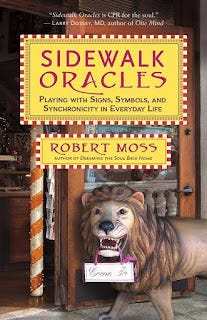“We can also walk the roads of everyday life as conscious dreamers, learning to recognize how the world is speaking to us in signs and symbols, and how a deeper order of events may reveal itself through the play of synchronicity.” Robert Moss, Sidewalk Oracles
A Willingness to Walk the Path
Today kicks off our shared reading of Sidewalk Oracles: Playing with Signs, Symbols, and Synchronicity in Everyday Life by Robert Moss.
Each week, I will post some general discussion, reflection, and thoughts on the chapter or “games" from the week. You are invited to share your experience with this book in the comments section.
Basic Information
📌 We are reading Sidewalk Oracles: Playing with Signs, Symbols, and Synchronicity in Everyday Life by Robert Moss.
📅 The reading timeline outlines a slow reading (with weekly discussion posts) for anyone who wants to read along.
🍥 I encourage you to go into this reading with an open mind and a willingness to consider what is being described/discussed.
🧵 I use the comment area for discussions rather than a chat thread. Neither would be private because this read-along is free to everyone. You are invited to comment on comments and interact with those reading together.
Getting Started and Week 1
Welcome to the Sidewalk Oracles read-along! I am happy you are here, and thank you to Adah for recommending this title to me in a comment one Sunday. I might never have stumbled over this book, so that feels, itself, like a moment of serendipity.
Leading up to this start, I’ve talked a bit about where I’m coming from in thinking about this book. I will be inviting you, below, to think about where you find yourself in this moment in time. Who are you as you begin this book? What is your relationship with this subject matter? Where do you fall on the spectrum of acceptance and disbelief?
The idea of this book has grabbed me, I think, because I do talk a lot about serendipity, symbols, and moments where I feel the universe is speaking to me. At the same time, my practical nature makes me sometimes awkwardly hold all of that a bit off to the side. I find myself torn.
In the month I’ve had this book checked out, waiting, it’s been like a beacon on the table. Something about the cover speaks to me. I want to dive in. I’m hopeful. I feel like I’m needing something, and maybe this book is a place to begin. What I’ve been asking myself is “what happens if I go all in and let myself really embrace and give voice to this part of me?”
That’s my entry point. It feels vulnerable. It feels a bit confusing. The part of me that thinks all of this may be silly is really strong.
[This post is from a 2024 read-along. The remainder of the post has now been placed behind the paywall.]



